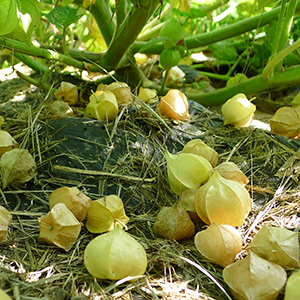
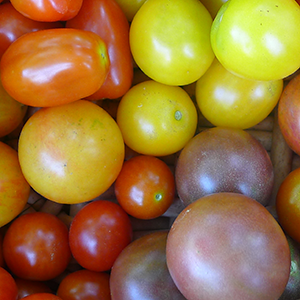
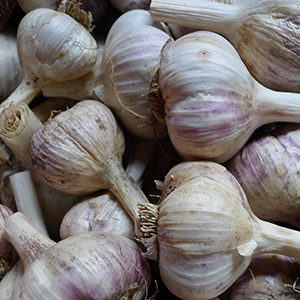

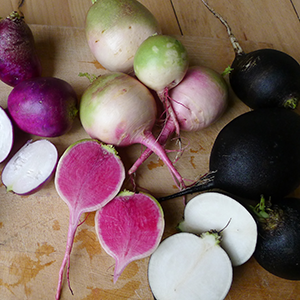
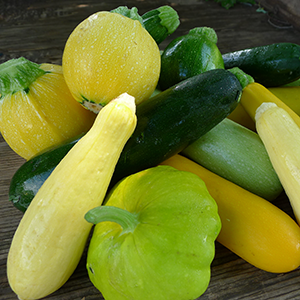
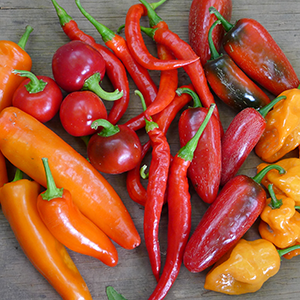



News and Notes | The Anchor Run Blog
Posts Filtered by Month - November 2017 |
Show Recent Posts
November 27, 2017
Leeks and Kale
By Linda Dansbury
Leeks and Kale
By Linda Dansbury
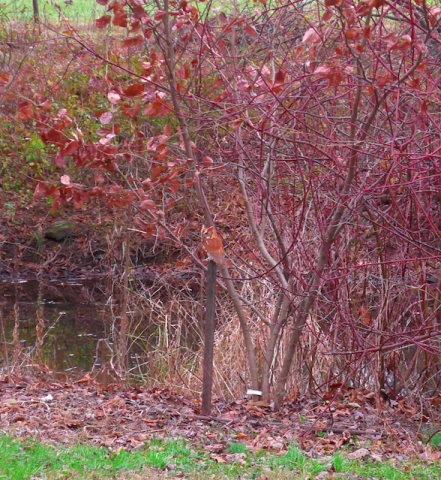
Can you see the Eastern Screech-Owl hangin' out by the pond/sandbox area?
Derek's mom shared an article based on an interview with David Tanis, who writes about how to get the best out of fresh, local veggies - Derek said there were questions in the pick up room asking what to do with leeks - I have talked about them, but maybe not in enough detail. Leeks are in the same family as onions and scallions, but the taste is much more subtle. Unlike onions and scallions, most people do not eat leeks raw. In David Tanis' words, "Don’t under-cook them—they don’t taste good if they’re crunchy.” But otherwise, he argues, leeks are not difficult to prepare. Cooking them in a pan with a pat of butter can result in something “absolutely delicious that you can kind of put anywhere”—in omelettes, or cradling a piece of fish, he suggests. Or try Tanis’ recipe for Leeks Vinaigrette. “In traditional French bistros, cooked whole leeks are dressed with a tart vinaigrette and served as a classic first course,” he writes. They’re “sometimes called ‘poor man’s asparagus’ (leeks are cheaper there than in North America).” If you have never made Potato Leek Soup, check out one of the variations on this site (Creamy Potato Leek Soup; Potato-Leek Chowder; Potato, Leek and Cabbage Soup with Lemon Creme Fraiche; Potato Kale Leek Soup).
After all the rich, filling foods of the holiday weekend, you might be looking for something lighter and healthy. If you are like me and your beautiful bunch of kale is still in the fridge, try the Kale Caesar Salad. Remove the thick mid-veins, stack the leaves and slice into very thin ribbons. Place in large bowl and massage - yes, massage the bowl of kale. After a few minutes, you will feel the difference in the texture of the leaves - they turn soft and silky - and when this happens, even the thick, mature kale leaves become tender enough to enjoy in a salad. I like to use OPA brand Caesar Dressing. It uses Greek yogurt as its base. It is much easier, and it is healthier than the traditional dressing, and it is delicious on kale. If you haven't tried this method, you are missing out on something amazing!

November 27, 2017
Brighten Your Meals
By Derek McGeehan
Brighten Your Meals
By Derek McGeehan
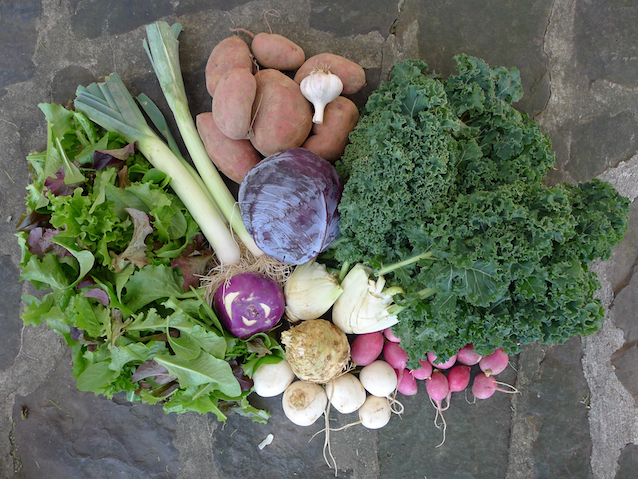
Late Fall Harvest #3 (Week A) should include kale, garlic, cabbage, lettuce/greens mix, sweet potatoes, an allium choice (leeks, onions), and root/stem choices (fennel, hakurei turnips, salad radishes, celeriac, kohlrabi).

November 27, 2017
Two and a Half Months of the 'Dark Time'
By Derek McGeehan
Two and a Half Months of the 'Dark Time'
By Derek McGeehan
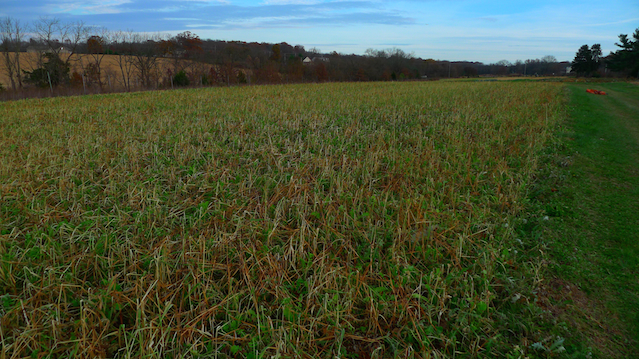
Now that many farmers and gardeners are pushing the boundaries of successful winter growing, dialogue and information are passed around and shared via literature and online/social media regarding successes, failures, experiments, conditions, variables, tools, data, terms, etc. Many growers refer to this time of year that we're currently in as the Persephone Period (from Greek mythology), when day-light/day-length drops under 10 hours. This period corresponds with reduced plant growth, a factor of light but also temperature. Our Persephone Period runs from approximately November 15th until January 30th, which ultimately has everything to do with our latitude, earth's tilt on its axis, and our revolution around the sun. Different latitudes endure varying lengths of daylight and darkness so the farther north you are the longer your Persephone Period.
Some examples of the influence of this period that farmers have identified: days to maturity triples in unheated cold houses like our high tunnel and doubles in minimally heated cool houses such as our green house. Due to minimal growth during this period it is critical to establish plants at appropriate times so that they grow just enough before November 15th. Sow the seeds too close to this time and plants will germinate and grow very, very slowly, almost hibernating until February. Even though February is colder than December (normally) plant growth resumes relatively quickly when day-length surpasses the 10-hour mark.
For many of our winter crops that are in our protective structures we hope to harvest 2-3 times over a 3 month period. In order to do so they must be well established prior to mid-November. The crops that go in too close to the start of Persephone will probably only be harvested once during February. So, by early February, halfway through astronomical winter, plants are already thinking about spring, especially (maybe only) inside our protective buildings where conditions create an environment more like North Carolina than southeastern Pennsylvania.
Question: When plants slow down and go quasi-dormant, do farmers respond in kind?
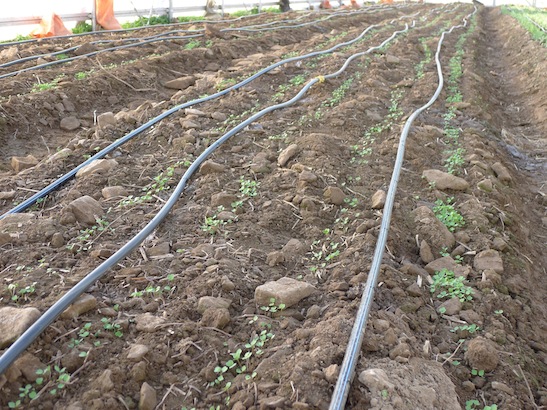
This arugula was direct seeded on November 4th, 11 days prior to Persephone, which may have been too close. During the warmer months arugula is ready for harvest approximately a month after sowing. This time of year it's more like 3 months, so we can look forward to eating this in early February. One way we study and compare plant growth during the winter is by taking weekly photographs of all of the crops in our 4 buildings. The goal is to have precise dates for winter sowing, though variables outside of our control include low and high outside temperatures as well as sunny/cloudy days which influence plant growth. Successive sowings help manage the unpredictable nature of nature.

November 27, 2017
Holiday Wreaths For Sale
by Dana Hunting
Holiday Wreaths For Sale
by Dana Hunting
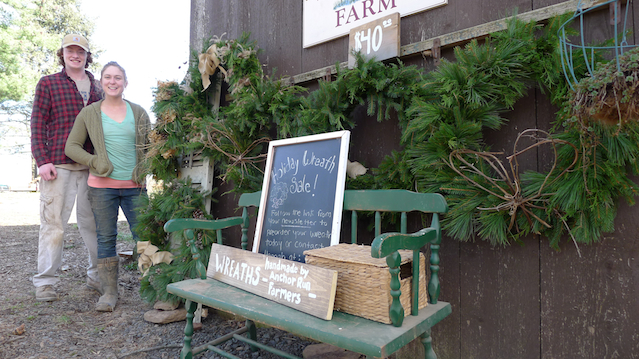
Holiday Wreaths Made by Farmers Hannah and Pat
- Hannah and Pat are hand-making wreaths using materials from the Anchor Run Farm and surrounding woodlands. Orders are now being taken. They'll also have a few to sell during pick ups but preordering is recommended because supplies are limited.
- Please follow the link for more information and to order.
- If you have any questions contact Hannah at hannah.r.conner@gmail.com.

November 27, 2017
Farmer Food
by Dana Hunting
Farmer Food
by Dana Hunting
Here are some ways we've been enjoying our share produce:
- Cabbage: cut in half or quarter, cut out core/stem, put in a baking pan/dish with butter or coconut oil or olive oil, sprinkle with salt, pepper, and any other spice of your choosing, bake at 375 for about an hour or until soft.
- Miscellaneous roots/radicchio: grate a variety of roots including radishes, turnips, kohlrabi, celeriac, beets onto a plate and into separate piles and add to a mixed greens salad; chicken stock soup.
- Potatoes/Sweet Potatoes: chop into french fries; lather with olive oil, coconut oil, or lard; spread on cookie sheet; sprinkle with salt, pepper, or another spice; and roast at 375 for about an hour or until crispy. Broiling at the end will help crisp. A good coating of oil/lard will keep them from sticking to sheet.
- Kale: breakfast smoothies with fennel, frozen strawberries, and dairy kefir.
- Leeks: chicken stock soup with miscellaneous roots and greens.
- Carrots: pure snacking!
- Radicchio: breakfast smoothies with fennel, frozen strawberries, and dairy kefir; salad.

November 19, 2017
A Balancing Act
By Derek McGeehan
A Balancing Act
By Derek McGeehan
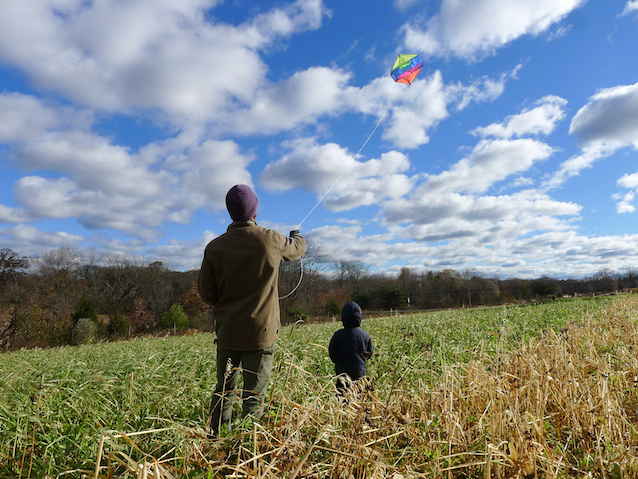
Almost too windy to fly a kite but a beautiful fall day overall!
Because we had the extreme cold of a winter night in early November our focus of late has turned towards our crops growing inside our four protective structures. Outside, many of our field crops received enough damage to render them unharvestable. Outside crops that are still worthy of our attention include cabbage, radicchio, kale, collards, hakurei turnips, scarlett queen turnips, and a few others. Besides these we may eventually be able to choosily pick some spinach and arugula, but for now we'll rely on some of the hardier greens.
Inside and protected crops include arugula, kale, spinach, mizuna, red mizuna, tatsoi, lettuce mix, claytonia (salad green), and a few special others. There are several successions of many of these crops but unfortunately the earliest our first planting will be ready is Late Fall week #3/early December. Based on our experience from past seasons we typically don't need to rely on the indoor crops until December and plan for such. Planting dates are coordinated based on when we want to harvest.
It's a tough balancing act this time of year, maintaining appropriate day and night temperatures inside, trying to train the crops to become accustomed to low temperatures while also encouraging them to grow fast enough for harvest. Warmth and light speeds growth, but too much warmth and growth will make them more susceptible to extreme cold (which happened to the outside crops). With outer layers of plastic plus inner layers of row cover our indoor crops are not frequently subjected to extreme cold, but we do expect to have a few nights in the single digits outside this winter and we do want them to tolerate lows in the 20s inside their nests. So, with fluctuating temperatures means opening and closing (venting) the buildings, mostly manually. Our greenhouse is the only structure with automated temperature controlled settings, but with an exhaust fan that currently doesn't open its own shutter properly, it means we need to manually open the door on sunny days. All of the other structures have doors, too, plus roll-up or drop-down sides for ventilation along the entire length on both sides.
Also in consideration are moisture and humidity inside these buildings. Both can contribute to mildews which can be detrimental to crop health. Venting for this reason occasionally is required. But, we don't want the crops to dry out too much either since that also makes them more susceptible to the cold. And, to grow, they need water, which we have to add through drip tape, since they're protected from the outside elements.
Thus, we strive to find the appropriate balance between factors we can control and we are thankful we have the ability to control the factors just enough to ensure decent yields of greens through the winter. At least that is our goal. Thank you for your support.
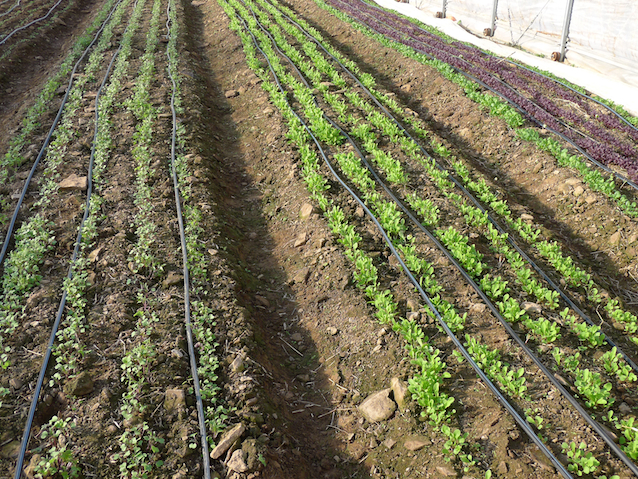
Drip tape on the first round of greens in the high tunnel: red russian kale, arugula, red mizuna, and tatsoi.

November 19, 2017
Back to Normal November
By Derek McGeehan
Back to Normal November
By Derek McGeehan
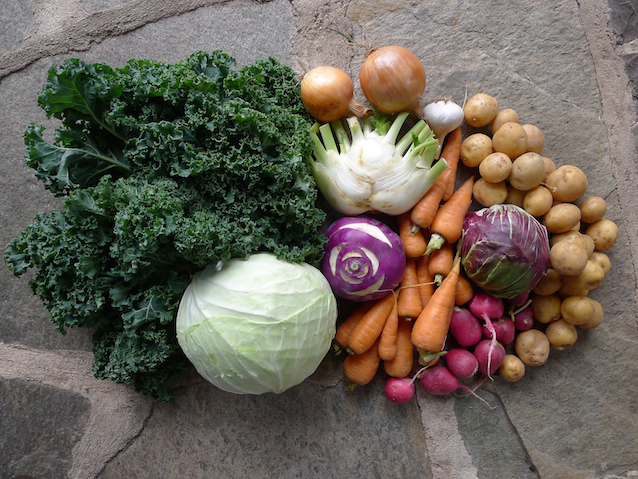
Late Fall Harvest #2 (Week B) should include potatoes, carrots, a root/stem choice (radishes, hakurei turnips, fennel, kohlrabi), kale, cabbage, radicchio, an allium choice (leeks, onions), and garlic.

November 13, 2017
Eat Your Fall Veggies!
By Linda Dansbury
Eat Your Fall Veggies!
By Linda Dansbury
Normally I take a hiatus from the newsletter once the Main Season is finished. Derek and I agreed that if I found something that I wanted to share, I would, so the first week out I made a dish I found about a month ago: Braised Coconut Greens & Chickpeas with Lemon.
The recipe calls for spinach but I used a mix of dandelion greens, broccoli raab, Swiss chard (including the stems) and a little kale. The recipe calls for putting the mixture on top of a baked sweet potato, which I did. I LOVED the dish and hope you do too.
If you want to share a recipe or idea for using all these wonderful greens and veggies, please email it to me at lindadansbury@comcast.net

November 13, 2017
Resilient Cold Survivors
By Derek McGeehan
Resilient Cold Survivors
By Derek McGeehan
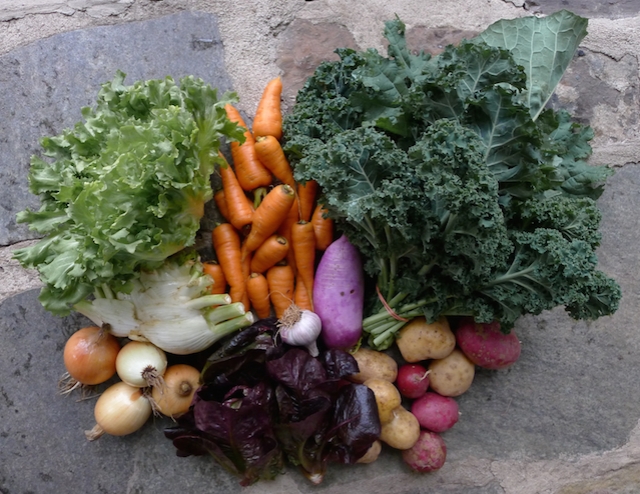
Late Fall Harvest #1 (Week A) should include potatoes, carrots, a root/stem choice (radishes, hakurei turnips, fennel, celeriac, kohlrabi), kale, mini lettuce, escarole, an allium choice (leeks, onions), and garlic.

November 13, 2017
Brief Arrival of Winter with Late Fall CSA
By Derek McGeehan
Brief Arrival of Winter with Late Fall CSA
By Derek McGeehan
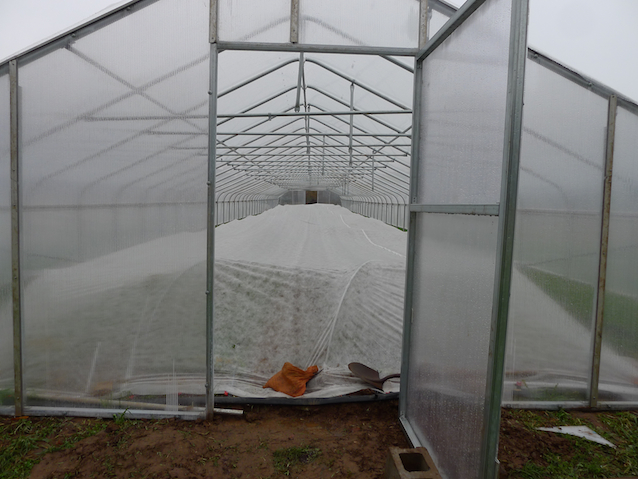
A view from the west end of our new hoop tunnel with inner layer of hoops and cover. Plants are kept warm and safe inside.
Mild, warm, hot, balmy, above-average, light frost, hard freeze, extreme weather = very thankful for our 4 winter growing structures: hoop house, green house, high tunnel, and hoop tunnel!
First the good news: as of Monday morning all of the fresh greens in our structures survived unscathed and field crops of kale (several hardy varieties) plus collards seem fine. It takes several days for plants to show damage or health after a freeze like the one we had so by midweek we'll probably be able to identify fully what we lost and what survived. Either way, we have hundreds of bed feet of kale to eat for the next year and a half. And, we have enough greens in the structures to keep all of us happy through the fall and winter months! We also harvested a lot of red cabbage, napa cabbage, lettuce, and escarole prior to the potential damage. Storage crops are obviously safe and okay.
A tough reality: we had our first taste of January weather but unfortunately in arrived in the first half of November instead. Record breaking cold following weeks/months of uncharacteristically warm weather surprises plants as well as us humans. The best case scenario for our field crops to tolerate a deep freeze is a slow cool down with a few minor frosts (36 degrees), hard frosts (30-32 degrees), and minor freezes (26-28 degrees) of immature and still growing plants, giving them a 'taste' of what's eventually coming. Last weekend's scenario was basically the opposite: most of our outside crops were fully mature after growing extremely quickly during the warmth of September and October and during October and early November we hardly had any light frosts, let alone a freeze of some kind (on average we receive our first light frost during the 1st half of October; our first heavy frost/light freeze the 2nd half of October). So, a low of 19 degrees is an extreme shock to a stationary plant that is used to lows above 40 degrees. Even with a gradual cool-down of some kind, temperatures in the teens will severely damage most unprotected crops. Heavy layers of floating row cover over top of low hoops can protect a certain amount (2-6 degrees) but wind greatly diminishes the efficacy.
Enter the super/mega/ultra importance of our bigger structures! The outer plastic layer protects 5-10 degrees and an inner layer of hoops and cover adds another 5-10 degrees of comfort. So, when it's 10 degrees outside, under the inner layer of a structure it might only be 30 degrees, all without the aide of supplemental heat. Additionally, our green house has the option of supplemental heat as added insurance, so we should be eating fresh greens all winter long no matter the weather!
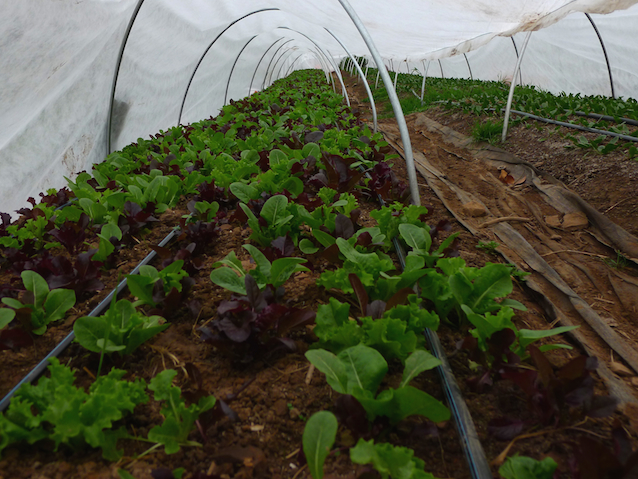
A view under the inner cover inside our hoop house. The lettuce mix is almost ready to be harvested.

November 13, 2017
Late Fall and Winter Newsletters
by Dana Hunting
Late Fall and Winter Newsletters
by Dana Hunting
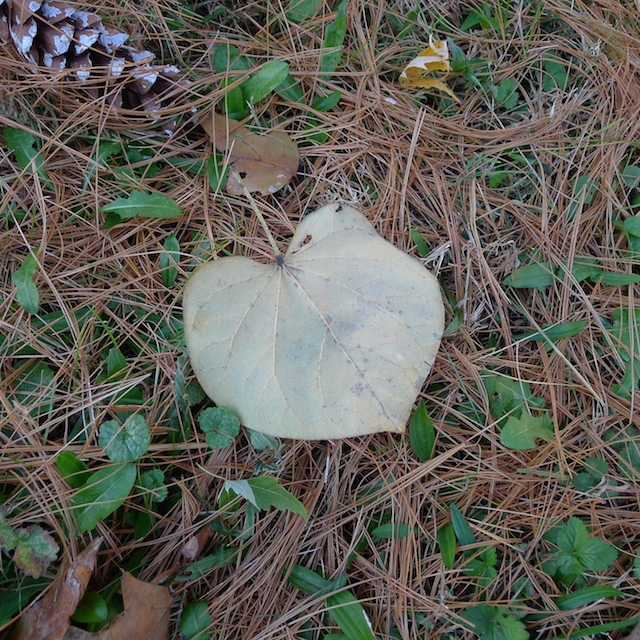
A heart-shaped redbud leaf nestled amongst white pine needles and brave perennial greens/edible weeds (I see some dandelion and plantain in there).
Newsletters for the Late Fall and Winter CSA seasons will most likely be distributed on Mondays instead of Sundays. Now that Monday is not a harvest and distribution day we're hoping we can take Sunday off from physical and administrative farm work and instead work on the newsletter on Monday morning. Thank you for your understanding!

November 13, 2017
Late Fall CSA Pick Up Information
by Dana Hunting
Late Fall CSA Pick Up Information
by Dana Hunting
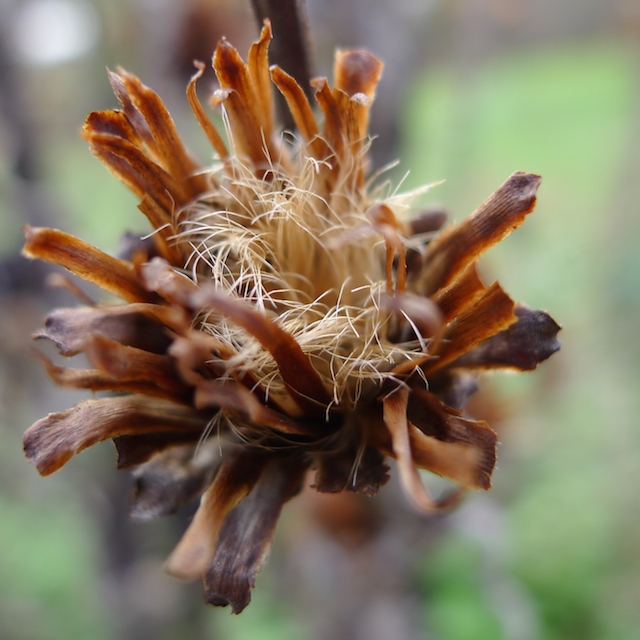
Elecampane blossom dried and ready to spread its seeds via wind dispersal.
- Pick up days: Wednesday 1-8pm and Saturday 11am-12noon, which you sign up for in advance.
- During the week of Thanksgiving, pick up is on Tuesday 11/21 1-8pm to accommodate holiday traveling and planning. Pick up is still scheduled for Saturday 11/25 11am-12noon.
- Full and Medium Shares pick up weekly, Half Shares every other week (A or B).
- Pick up continues this week for Full and Medium shares; Week B Half Shares begin this week (log in to check your week).
- You can temporarily switch your pick up day/week be notifying us by 5pm Sunday prior to your pick up day/week.
- If you miss your pick up we will contact you to reschedule.

November 5, 2017
You Decide
By Derek McGeehan
You Decide
By Derek McGeehan
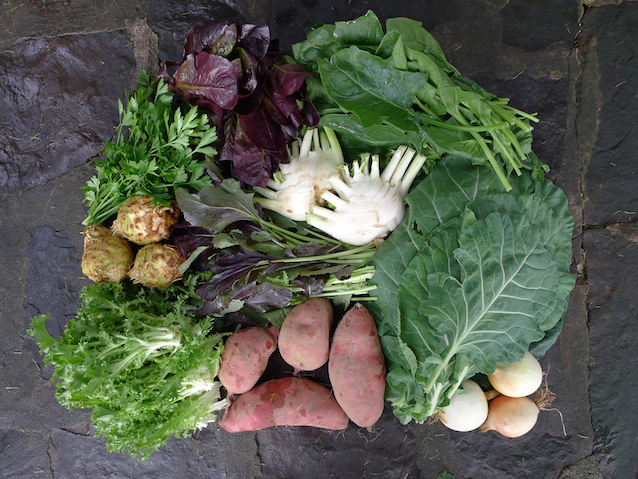
Harvest #26 (Week B) should include sweet potatoes, spinach, lettuce, a cooking greens choice of kale/collards/chard, a salad/cooking greens choice of arugula/greens mix/chicory, a root/bulb choice of beets/hakurei turnips/radishes/kohlrabi/celeriac/fennel, an allium choice of onion/leek, and an herb choice of probably parsley/sorrel. U-pick is over for the season to allow perennial herbs a chance to rest and prepare for winter dormancy.

November 5, 2017
Workshifts Scheduled for Week of 11/5/17
by Dana Hunting
Workshifts Scheduled for Week of 11/5/17
by Dana Hunting
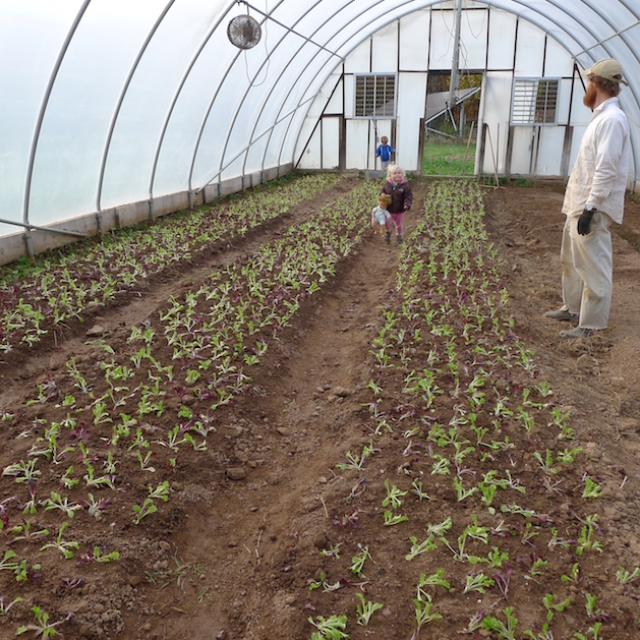
Fall and winter lettuce mix transplanted into greenhouse Friday morning with help from CSA members during workshift.
Still owe work hours?
If you still need to work your pledged hours please consider signing up for a workshift very soon! Your opportunity to work will be over in a week or two (weather/jobs depending). We still have to plant and mulch the 2018 garlic and will need member help with that (exact date to be determined but we'll probably embark on it this week).
If you purchased a CSA share "with work discount" instead of a full price share "without working" it meant that you committed to helping out on the farm a set number of hours (Half Share=4hrs; Medium Share=6hrs; Full Share=8hrs).
It's no problem if you weren't able to get your hours in, it just means that you need to square your balance by contributing financially to cover the difference. And please don't feel guilty about it! The buyout option makes it fair for all members. It's also the main reason CSA share prices have remained the same since 2008!
$15/hour covers your missed hours.
Pretty soon we'll go through the member list and add the missed hours to your account so that when you sign in to the website you'll be able to see your new balance if you weren't able to work. We'll probably also e-mail you a reminder.
Contact us at anchorruncsa@gmail.com if you have any questions.
Workshifts this week:
- Tuesday 11/7 10am-12noon (garlic?)
- Wednesday 11/8 10am-12noon (garlic?)
Workshift sign-up instructions may be found here.
Thank you!

November 5, 2017
Remember To Sign Up For The Late Fall CSA!
by Dana Hunting
Remember To Sign Up For The Late Fall CSA!
by Dana Hunting
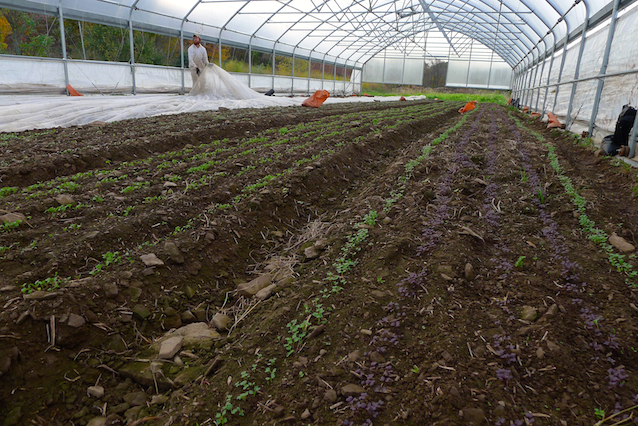
The first round of direct seeded kale, arugula, tatsoi, and red mizuna is coming up nicely in our movable high tunnel while the second round of greens gets covered and watered to assist germination. Most of these greens will be harvested in January and February.
As of this weekend produce shares are still available for the 2017 6th Annual 6-week Late Fall CSA (we're 75% sold out).
To join, Log In to the website. Not sure if you'll enjoy local cold season produce? A Late Fall Half Share is only a 3 week, every-other-week commitment and is a great way to provide produce for your holiday meals. Where else are you going to find organic and affordable sweet potatoes, potatoes, carrots, roots, and greens that taste this good? We promise to leave you satisfied!
Please click here for more information and share specifics.
First pick up for Full, Medium, and Week A Half Shares is Wednesday November 15th 1-8pm or Saturday November 18th 11am-12noon. Week B Half Shares start on Tuesday November 21st 1-8pm or Saturday November 25th.

November 5, 2017
We Bid Thee Thanks and Farewell
By Derek McGeehan
We Bid Thee Thanks and Farewell
By Derek McGeehan
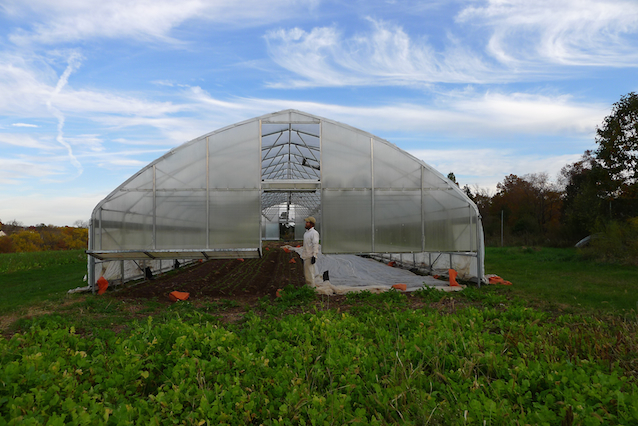
At this conclusion to the Main Season CSA we say, think, write, and feel thankful to you, our CSA members, for your support, help, interest, trust, commitment, and sense of eating adventure. We recognize that a half year of local produce consumption can be quite a daunting task and that we're fortunate that you've asked us to be your produce farmers.
Without you and your support our CSA wouldn't be as successful as it has been for 14 years. We're grateful that every season we meet our membership goal, a number that is capped at 250 weekly member pick ups so that we can focus on growing the best produce for you that is potentially possible on our central Bucks County farm. We're not expanding our business or farm but are instead acquiring the experience and skills to properly serve our committed CSA members.
With your trust and support over the years we have the confidence to adjust our practices and shares to try to give you what you want in a CSA share. For obvious reasons it's impossible to please 100% of you 100% of the time, but we do try, trust me! We care about your opinions and want you to be able to eat our nutrient dense food to stay healthy and live an enriched life. Good soil = good food = good mind and body = good community. Thank you for allowing us to serve you!

November 5, 2017
2017 Main Season Survey
by Dana Hunting
2017 Main Season Survey
by Dana Hunting

We've created a short anonymous survey that gives you the opportunity to shape your CSA by letting your farmers know your valuable opinion! Please fill it out for us so that we can better serve you, our CSA members.

November 5, 2017
Delicious Dinners
By Linda Dansbury
Delicious Dinners
By Linda Dansbury
I am so happy with all the delicious veggies we are receiving and look forward to figuring out what to cook. At least a few mornings (or the evening before) I either go through a cookbook or search the internet to decide on what I can make for dinner that is reasonably easy/fast if it is a week night and of course it has to be delicious. Here are a couple of things we ate this past week.
Leeks, garlic, cilantro, hot pepper - I have a chef Ming Tsai cookbook that was given to me. The theme is one-pot meals and has sections focusing on different cooking methods. The recipes are generally healthy, incorporate a lot of the veggies we receive, and all that I have tried have been delicious. This one called for using a pork tenderloin, slicing it very thin and marinating the meat for 30 min in a mix of garlic, soy sauce, sesame oil, worcestershire sauce and thinly sliced hot pepper. Slice leeks lengthwise into thin ribbons. Stir fry the meat over high heat until nearly cooked, 4-5 minutes. Remove from wok. Add thinly sliced ginger and leeks and stir fry until leeks are nicely wilted, about 3 minutes. Add meat back into wok and mix everything up and heat the meat. Serve over whatever grain you like - we used farro and it was delicious with it. Topped with some cilantro.
Spinach, onion, rockfish (from Wild for Salmon), dill - placed a nice bed of spinach in the bottom of an oven proof dish large enough to hold the fish filets. Placed fish on top of spinach, then added dill, seasonings (people have given me various spice blends and I took this opportunity to use one of them), some veggie stock, slices of lemon and thin slices of onions, halved cherry tomatoes. Cover all with foil and place in a 400 degree oven for about 20 minutes. Served over whatever grain you like - we had quinoa.

November 5, 2017
Final week of Main Season
By Linda Dansbury
Final week of Main Season
By Linda Dansbury
It is difficult to believe that 6 months have gone by already! Thank you to fellow members who took the time to send me your ideas and recipes. You are great cooks and I have truly enjoyed the recipes and the stories behind them!
Sorrel is one of the herb choices right now and you may not be familiar with it. It is a perenniel herb loaded with vitamins A and C. It has a tart, lemony taste. A classic French recipe incorporates it in a lemony sauce (without using lemons) used with fish. Sorrel soups are part of both French and Polish cusines.
For the amount we are receiving, you could make a little batch of sauce for fish, or do what I am doing: adding a few leaves to salads - it is very refreshing, or use in combination with spinach and/or chard in any recipe. It will keep in the fridge for a little over a week.

November 5, 2017
Holiday Wreath Sale, Made by Farmers Hannah and Pat
by Hannah Stocker
Holiday Wreath Sale, Made by Farmers Hannah and Pat
by Hannah Stocker

Farmers Hannah and Pat would like to announce their holiday wreath sale!
They will be hand-making wreaths using materials from the farm and are taking orders starting today, November 5th. Hannah is a very experienced wreath maker extraordinaire!
If you have any questions contact Hannah at hannah.r.conner@gmail.com.

POSTS BY TYPE
POSTS BY MONTH

